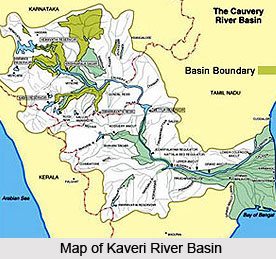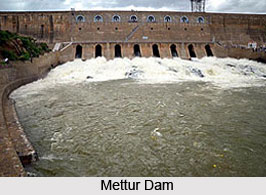 Kaveri River, also known as Cauvery River, is one of the major rivers of southern India, which is considered sacrosanct by the Hindus. The river rises at Talakaveri in the Brahmagiri hills of the Western Ghats in Karnataka. It flows in the south and east through Karnataka and Tamil Nadu and then across the southeastern lowlands and finally surrenders in the Bay of Bengal through two principal mouths.
Kaveri River, also known as Cauvery River, is one of the major rivers of southern India, which is considered sacrosanct by the Hindus. The river rises at Talakaveri in the Brahmagiri hills of the Western Ghats in Karnataka. It flows in the south and east through Karnataka and Tamil Nadu and then across the southeastern lowlands and finally surrenders in the Bay of Bengal through two principal mouths.
History of Kaveri River
The history of Kaveri River is still untraceable. Kaveri River is one of the sacred rivers of the country and thought to be the Dakshina Ganga or Ganga of the South. The Hindu Mythology says several versions about the descent of River Kaveri. The most popular one is that a king by the name of Kavera lived in the Brahmagiri hills and prayed to Lord Brahma for a child. He was blessed with a daughter whom he named Kaveri. She was the water manifestation of the human form. The great sage Agastya married her and kept her in his kamandalu or the spouted jug. When a terrible drought trounced the land, Ganesha in the guise of a crow, tipped the kamandalu and out flowed the Kaveri. Thus, Kaveri River is embodied as the Goddess Kaveri Amman, who is worshipped at several shrines along the course of the river.
Origin of Kaveri River
The origin of the River Kaveri is at the Talakaveri (Western Ghats) of Karnataka. River Kaveri originates in the Brahmagiri hills in Kodagu. This place is called Talakaveri or the head of Kaveri. The river starts its journey from the small pond called Kundike, the two tributaries known as Kanake and Sujyoti joins it later in the course. All these three rivers meet at the point called Bhagamandala. It lies at an altitude of 1350 meters and generally flows from the direction of south to the eastward direction.
Geography of Kaveri River
The geography of River Kaveri starting from its origin reaches up to the fertile plains at its lower course. The river has an approximate length of 760 km. As the river flows in the Deccan Plateau, it forms two islands, Srirangapatna and Shivanasamudra. The river also joins the Hogenakal Falls before arriving in the town of Hogenakal and Srirangam in Tamil Nadu. It then meanders in the southern plains and in the Thanjavur district; silt-laden river delta is formed before it falls into the Bay of Bengal.
 Tributaries of Kaveri River
Tributaries of Kaveri River
The tributaries of River Kaveri are responsible for the water resource in southwest India. The tributaries are, Harangi River, Hemavati River, Lakshmana Tirtha, Kabini River, Shimsha River and Bhavani River.
Kaveri River as a Source of Irrigation
The waters of the river have been an important source of irrigation since primitive days; as early as the 1990s. Survey shows that around 95 % of the Kaveri was used for agricultural purpose before flowing into the Bay of Bengal. The delta of the Kaveri is so mature that the main river has almost lost its link with the sea. An estimate at the time of the first Five Year Plan puts the complete flow of the Kaveri at around 12 million acre-feet, of which 60% was used for land irrigation. The Torekadanahalli pump station sends 540 Mld (million liters per day) of water from Kaveri to Bangalore.
Dams on Kaveri River
The river water is the source of extensive irrigation project and for the generation of hydroelectric power. Dams constructed across the river are Krishna Raja Sagara Dam and Mettur Dam and the Banasura Sagar Dam on the Kabini River, which is the tributary of Kaveri River. This sacrosanct river has been mentioned in Tamil literature. A large number of temple towns are situated in the lower course of the Kaveri River in Tamil Nadu.
Kaveri River Basin
Kaveri River basin is estimated to be 27,700 square miles. The geology of Kaveri River accounts for the floodplain sediments in the river basin. The soil produced by the tide and flow of River Kaveri is rich and best for agricultural purposes. The floodplain sediments of the river are derived from Archean gneissic and charnockitic source regions, thus revealing the inter-bedding of silty and sandy units. The geochemistry of silty beds is amazingly uniform at a given location and over a tangential distance of almost 250 km. The sandy beds have more inconsistent chemical compositions, yet are comparable to those of silty beds; the only limitation is the diluting effect of quartz. Silty sediments possess the geochemical signature of prominently exposed source rocks for almost all elements and provide proofs of tectonic unsteadiness in the primary source region.
Kaveri River in Two Different States
River Kaveri in Karnataka has several channels with dams. In its course through Karnataka, the channel is broken up by twelve "anicuts" or dams for the reason of irrigation. From the anicut at Madadkatte, an artificial channel is diverted at a distance of 72 miles, irrigating an area of 10,000 acres and ultimately bringing its water supply to the town of Mandya. River Kaveri in Tamil Nadu features lovely waterfalls and gorges, which serve as great tourist spots. Among them the most famous is the Hogenakkal falls in Dharmapuri District. The three minor tributaries of River Kaveri, flowing in this state are Palar, Chennar and Thoppar above Stanley Reservoir in Mettur, where the dam has been constructed.
Kaveri Water Sharing
The water sharing of Kaveri River has undergone several disputes over the year. After the water disputes related to the water sharing of Kaveri River, water is addressed in the Constitution of India. The government has set up tribunals for water disputes. The Kaveri Water Disputes Tribunal was set up in June 1990 and has not concluded negotiation. Kaveri water sharing has been a major issue of contention between the states of Karnataka, Tamil Nadu, Kerala and the union territory of Pondicherry. A central government charity has been formed to look into this matter.